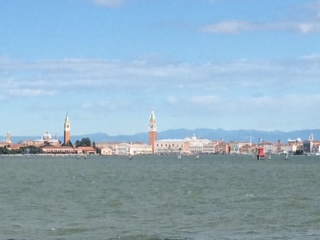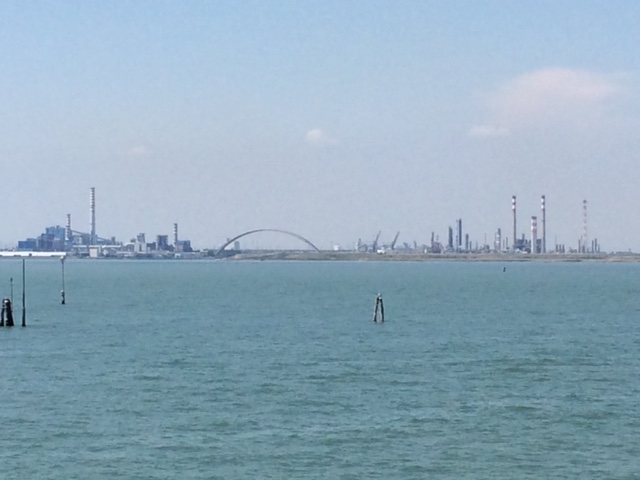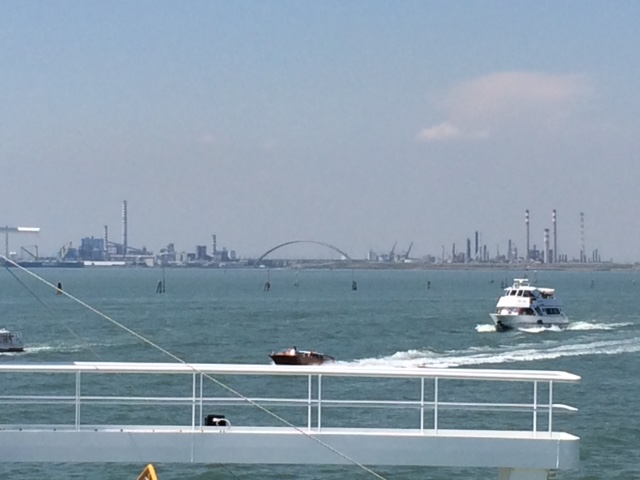Simona Grano, Department of Sinology, University of Zürich.
In my professional capacity as academic, I work on industrial pollution issues in China and Taiwan (Grano, 2016/2015). I am so absorbed by the need to keep up with what happens in these two places, that I rarely pause to think about what has gotten me interested in such issues in the first place; more specifically, how my personal background has spurred my academic interests.
I grew up in the city of Venice, famous all over the world for its majestic beauty, its canals and the feeling of magnificence that its alleys and palaces still exude;  however, Venice has a much darker side, which is rarely talked about and remains unknown to most of its visitors, despite it being highly visible from incoming planes.
however, Venice has a much darker side, which is rarely talked about and remains unknown to most of its visitors, despite it being highly visible from incoming planes.
Venice is in fact one of the few places in Italy (together with Ferrara, Ravenna, Mantova and a handful more) that host a vast industrial park primarily focused on the petrochemical sector: Porto Marghera.
To avoid negatively impacting the historical city and tourism “by 1917 the Italian government had decided to develop an industrial zone and state of the art port at Marghera on the mainland opposite Venice” (Madden, 2012). The area, which back in the 1940s already employed over 17,000 workers scattered among some 100 facilities (Fabbri, 2003: 27) grew exponentially throughout the years and underwent two big expansions with a second and a third industrial zone being built in the 50s and 60s, reaching a total area of 13,000 square meters by the end of the decade; by the late 1960s Porto Marghera employed 7,800 workers in the chemical sector alone (Ibidem: 29). A variety of toxic gases and substances produced here were used for nefarious scopes such as sulfur in the 30s, which was utilized to prepare Sulfur mustard[1], a toxic gas used in the Ethiopia war in 1936 (Ibidem: 27). So it is that the Northeast became one of the most important industrial areas as well as one of the most polluted places in Italy; a fact that many unaware tourists, who bathe in the Lido’s waters, still ignore (as do many of its inhabitants, for that matter).
 From the beautiful island of Lido, famous for hosting the Venice International Film Festival every September as well as for its pretty beaches and lavish hotels, directly facing Marghera it is possible to observe the industrial park’s chimneys; spewing out gases and churning flames that are especially visible at night, they form a surreal contrast with the surrounding tranquility of the laguna and the beauty of Venice and its grandiose palaces.
From the beautiful island of Lido, famous for hosting the Venice International Film Festival every September as well as for its pretty beaches and lavish hotels, directly facing Marghera it is possible to observe the industrial park’s chimneys; spewing out gases and churning flames that are especially visible at night, they form a surreal contrast with the surrounding tranquility of the laguna and the beauty of Venice and its grandiose palaces.
 Incidentally, the Lido is also where I grew up, where I played and swam for various summers and where, later, I spent innumerable nights drinking wine and chatting with friends in bars located alongside the laguna, opposite the industrial-jungle landscape of Marghera.
Incidentally, the Lido is also where I grew up, where I played and swam for various summers and where, later, I spent innumerable nights drinking wine and chatting with friends in bars located alongside the laguna, opposite the industrial-jungle landscape of Marghera.
Throughout the years the industrial park has been marred by a series of incidents and its reputation has been tainted by a big scandal regarding the safety of its workers, which later became a legal dispute.[2]
I remember in 2001 when a toxic gas release prompted the local authorities to declare an emergency situation and alerted the nearby areas of Malcontenta, Mestre and Venice (La Repubblica, 2001). I was at a friend’s house at that time and we were about to head home when his mother turned on the news. She then gave us two handkerchiefs to cover our mouths with and sent us on our way. I doubt that such a countermeasure indeed helped but I do remember the strange feeling of walking in the eerily empty alleys, clutching the tissue in front of my mouth and nose as if my life depended on it.
Truth be told, we might have been overreacting a little but then maybe not. The problem in fact, is that this kind of pollution is invisible thus altering people’s perception of a real danger. We trick ourselves into believing that if something is not visible then it does not exist.
Judging from similar “unseen” pollution incidents, such as Fukushima and Chernobyl, we should know better.
Per se I am not against development. I actually think that progress, science and technology, if used wisely, can (and have – just look at the advances we have made in the medical field) make our lives better.
I see a common thread of human corruption; men are capable of concealing crucial facts, which would benefit factories’ workers safety, just to increase profits.
What worries me though, is that no matter whether I do research on Taiwan or on China or whether I look at my own backyard, I see a common thread of human corruption; men are capable of concealing crucial facts, which would benefit factories’ workers safety, just to increase profits.
Countless lives have been lost in similar cases all over the world: Taiwan and the RCA case[3], China and its widespread industrial pollution issues and cancer villages, Italy and Porto Marghera and many more.
So the thing we need to fight against is corruption. We need to make sure that we can develop a technological progress, which does not wreak havoc on the surrounding natural resources and nearby fauna and is respectful of workers. To achieve this environmental activists and eco-friendly citizens also need to learn that being a priori against development is not the best solution. We need to fight for more transparency, more respect for industrial plants’ workers and in the direction of trying to diminish corruption and clientele networks existing among some developers, who still place profit ahead of public safety. If we can achieve this we shall be able to create a development that can actually improve our quality of life rather than shattering it.
References
Bettin, Gianfranco. 1998. Petrolkimiko; Baldini & Castoldi.
Fabbri, Fabrizio. 2003. Porto Marghera e la laguna di Venezia. Vita, morte, miracoli. Milano: Jaca Book.
Gaia Italia. 2001. “Petrolchimico di Marghera. Tutti Assolti.”
Grano, Simona A. 2016. “China’s changing environmental governance: Enforcement, compliance and conflict resolution mechanisms for public participation”. China Information 30(2): 1-4.
Grano, Simona A. 2015. Environmental Governance in Taiwan: A New Generation of Activists and Stakeholders. London and New York: Routledge.
La Repubblica. 2001. “Paura a Marghera e fuga di gas dal petrolchimico”. April 1.
Madden, Thomas F. 2012. Venice: A New History (Hardback). New York: Viking.
Taipei Times. 2015. “Former RCA employee win decade-long legal battle”. April 18.
Simona Grano is Teaching and Research Fellow at the Department of Sinology, University of Zürich. Her research interests include Chinese contemporary society, environmental law and legal awareness, environmental issues in China and Taiwan, and green social movements.
[Featured images credit Simona Grano]
[1] Despite its seemingly harmless name Sulfur mustard, commonly known as “mustard gas”, is a cytotoxic and vesicant chemical warfare agent with the ability to form large blisters on the exposed skin and in the lungs.
[2] The Company Montedison, located in the industrial park, has been brought to court and accused of having neglected to protect its workers for years, knowingly allowing them to work in unsafe conditions, getting them exposed to toxic gases such as vinyl chloride monomer, used to produce PVC; 157 workers died and 103 got sick. In 1998 a public prosecutor named Felice Casson decided to bring to court the management of Montedison, Enichem and Enimont (Gaia Italia, 2001). In 2001, 28 indicted individuals were acquitted; however, a second appeal overturned the first verdict and handed down convictions for 5 of the top managers. In reality though, the sentence remained purely symbolical given the statute of limitation. An oral history of the workers and families of those whose life got shattered by the petrochemical plant ensued (Bettin, 1998).
[3] Radio Corp of America (RCA) operated in Taiwan from 1970 to 1992, with plants in Taoyuan County, Hsinchu County, and Yilan County, employing tens of thousands of people in the production of color TVs and other electronics products; using up to 31 types of organic solvent, including trichloroethylene and tetrachloroethene, exposure to which increases the risk of cancer. Furthermore, in 1998 the Environmental Protection Administration (EPA) discovered that the company had illegally dug wells to discharge the toxic waste. Doing so, it contaminated tap water used by its workers and nearby residents. The site has been defined as one of “permanent contamination” by the very same EPA and eventually more than 1.300 former workers contracted various types of cancer (Taipei Times, 2015).
